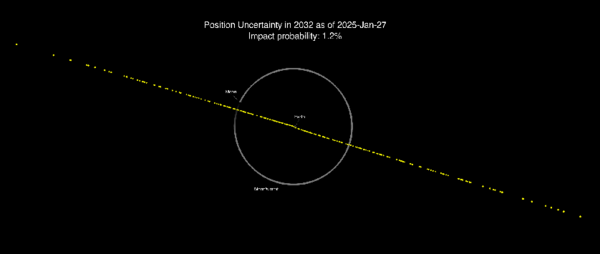Asteroid 2024 YR4 Possible Impact Raised Eyebrows: Skywatchers Continue Working as Guardians of Earth
As skywatchers around the world search the sky for Potentially Hazardous Asteroids, 2024 YR4 became high on the list to impact Earth in December 2032. Although the status of such threats can change from likely to not at all, USGS scientists and others are always working to protect and inform the public about the hazards that occur in “Earth life” to keep us safe.
Although eyes were initially closely watching 2024 YR4 and its potential to impact Earth, NASA has since eased our minds, by stating the latest calculations now show it’s no significant threat to Earth in 2032, and for the foreseeable future.
Dr. Tim Titus, Research Space Scientist at USGS Astrogeology Science Center, said "While no longer a threat, this provided a real-life test of the asteroid warning protocols."
When we hear about asteroids like 2024 YR4, most people recall the Chicxulub impactor that slammed in the Yucatán Peninsula. That’s because it carries the criminal record of wiping out the dinosaurs, and some animal and plant species, 66 million years ago. While some people would have loved to have seen dinosaurs, others are content to view their skeletons in museums and feel fear at the prospect of an asteroid approaching Earth.
Scientists have said impactors like Chicxulub occurs every 100 million years or so. So it’s millennia too early to pack up the family and pets, expecting an asteroid with catastrophic power to impact the blue marble any time soon. According to NASA, the likelihood of that is slim.
But this doesn’t mean scientists are out of the woods as they prepare for asteroid impacts all together.
First, we are no strangers to impacts: raising awareness!
In July 1994, the founder of Astrogeology, Dr. Euguene Shoemaker, and wife, Carolyn Shoemaker, and colleague, David Levy were responsible for showing the world a comet slamming into Jupiter, leaving for months an observable, deep, dark scar. The Shoemaker-Levy impact was a landmark event that raised the awareness about the risks of otherworldly objects, and the first time that astronomers were able to directly observe a comet colliding with a planet.
Earth’s satellite, the Moon, reflects its numerous scars from impacts of asteroids and comets. There is still a small possibility that 2024 YR4 could impact the Moon, and USGS scientists are preparing to observe this rare event in case it does. But as we research other planets to understand our home and support space travel, we recognize solar system bodies possibly can provide resources for space highways we plan to travel ahead.
Today our knowledge has increased about these rocky bodies, and humans are taking measures to be one step ahead of them. But there is no guarantee that an asteroid might not slip through before we can react. This was the case in 2013 with the Chelyabinsk airburst that injured more than 1,500 people.
BUT
Second, our eyes are watching them: monitor and monitor again!
NASA and other organizations continuously monitor and track near-Earth objects. The good thing is human eyes, telescopes, and software are all over the place monitoring the space that surrounds the Earth. These space watchers alert us when the next threatening space rock is approaching Earth.
Third, we’re focusing on asteroids or comets that matter now: frugal on spending!
Since asteroids like the one that caused Chicxulub isn’t expected in the near future, the focus is currently on smaller impacts capable of causing local or regional damage,” said Dr. Tim Titus. “We are working to support public safety, and security, particularly for people and regions who might be affected by impacts.”
In case of impact by one of the smaller asteroids, Dr. Tim Titus has alerted us of Cascading Hazards from asteroid or comet impacts. These are secondary hazards that emergency responders and community workers should investigate in an effected and surrounding community. It is paromount to consider not just the immediate effects, he said, but also the broader, long-term implications for the safety of Earth’s inhabitants.
Fourth, NASA implements a strategy: technology flourishes!
In preparation for planetary defense, in 2022, NASA tested changing the trajectory of an asteroid during its Double Asteroid Redirection Test (DART) program. The Eruopean Space Agency (ESA) has followed up the DART mission by sending its own mission, Hera, to investigate the damage done by DART.
These guardians of Earth work around the globe and clock in hopes for a safer tomorrow.
Get Our News
These items are in the RSS feed format (Really Simple Syndication) based on categories such as topics, locations, and more. You can install and RSS reader browser extension, software, or use a third-party service to receive immediate news updates depending on the feed that you have added. If you click the feed links below, they may look strange because they are simply XML code. An RSS reader can easily read this code and push out a notification to you when something new is posted to our site.



